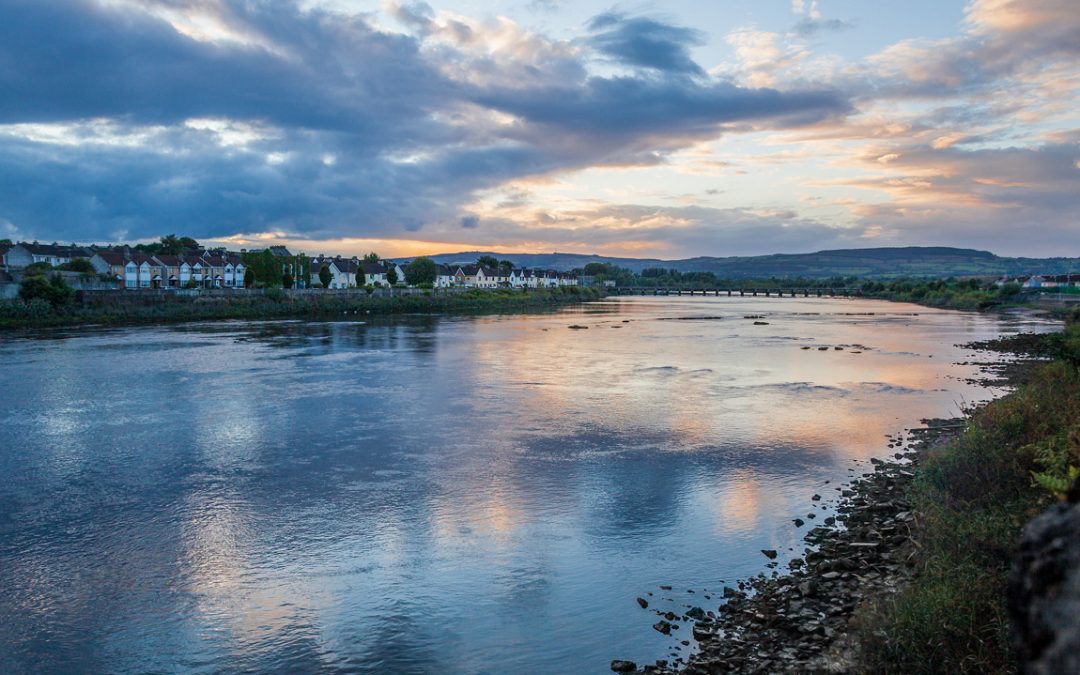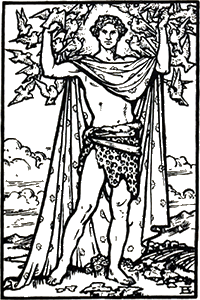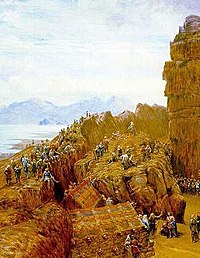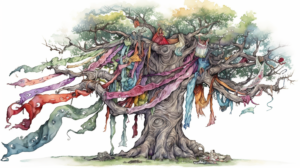Here are the name meanings for 12 of Ireland’s major rivers with a few myths thrown in along the way.
River Shannon
Abhainn na Sionainne
River of Sionann
Ireland’s longest river (shown above), flows south-west from Co. Cavan for 386 km (240 miles) through 10 counties and fors 3 lakes along its way to meet the Atlantic Ocean on the coast of Co. Limerick.
Legend attributes the name to the goddess Sionann, a granddaughter of the great Gaelic sea god Manannán Mac Lir, who made her way to the Cuilcagh Mountains (Cavan).
Magical knowledge would be gained by any who ate the fruit of the Nine Hazelnut Trees – even a fish. The salmon in the pool below would eat the fallen hazelnuts and become the Salmon of Knowledge of Irish mythology.
Sionann intended to eat the forbidden nuts from the Nine Hazelnut Trees of Knowledge which she knew had been planted by the Druids. It was forbidden for anyone but the king to enter this sacred space, but Sionann was determined. She eventually found the secret grove and discovered the magical hazelnuts laying there by the pool. But as soon as she tasted the fruit Sionann is instantly overwhelmed by a great torrent of water that bursts forth to consume her. It is for Sionann that the river is named.
The area of the river’s source is now known as the ‘Shannon Pot’. It is known as Lag na Sionna in Irish, meaning ‘the hollow of the Shannon.’ It is also known as the ‘Wise River’.
River Boyne
Abhainn na Bóinne
River of Boann
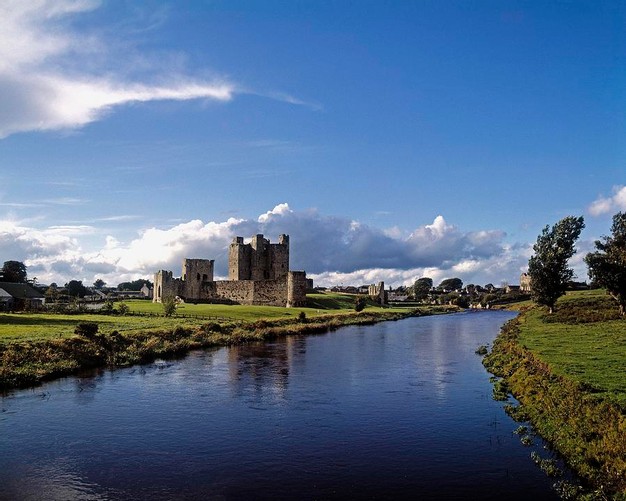
Rising in a place called Trinity Well in the Bog of Allen region of County Kildare, the Boyne flows northeast for 112 kilometres (70 miles) through the rich fields of the Boyne Valley of County Meath, taking in the great complexes of Brú na Bóinne (Palaces of the Boyne): Knowth, Dowth, and Newgrange, before entering the Irish Sea through Drogheda, County Louth.
The story behind its name involves a goddess of the Túatha Dé Danann called Boann (from Bó Fhind, meaning ‘white cow’). Boann was the mother of Aengus Óg (Angus the Young), the young and beautiful god who was later said to inhabit the great palace (or brú) of Newgrange overlooking the river that bore his mother’s name. Against her husband’s warning Boann proceeded to seek out the magical Connla’s Well. She knew it was surrounded by a grove of enchanted hazel trees whose hazelnuts gave wisdom to any who ate of them and which were known to sometimes fall into the well below to the delight of the hungry speckled salmon waiting there. Arriving at this mystical location Boann walks around the well a customary three times, but this gesture alone was enough to anger the waters which erupted from the well and drowned the goddess as they flooded across the land.
In later legends, the Salmon of Knowledge would be caught from these waters by a druid who sought to eat it and gain its power. Having been tasked with preparing the meal by the druid, the young hero Fíonn Mac Cumhaill (Finn McCoole) burns his thumb popping a blister on the fish’ skin. Instinctively putting it in his mouth to soothe the burn. Through this innocent act, he mistakenly tastes the fish and acquires the Salmon’s power for himself. After this, he could use the gift of knowledge by simply placing his thumb to his mouth.
River Lee
An Laoi
The Lee
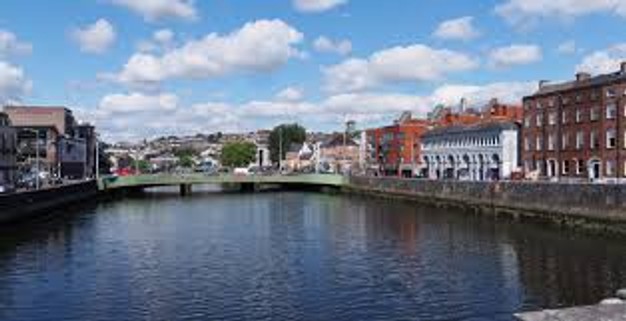
While the true origin of this river’s name is uncertain, there are two interesting legends associated with it:
The first attributes the naming of The Lee to St. Finbarr (c.560-610 AD), Cork’s patron saint. Arriving at Gougane Barra (Barra’s Rock/Crevice) in the Shehy Mountains on the Cork and Kerry border, the would-be site of his monastery, Finbarr is confronted by a monstrous serpent named Lú living deep within the waters of the lake (Saint Patrick presumably missed one or two serpents when he was doing his own banishing). Finbarr fights with Lú who flees from the site with the saint in hot pursuit travelling east across Cork’s rugged countryside. The path left in the landscape by Lú is said to be the course of the River Lee.
The second legend would see the name originating from a group of the Milesian race who settled in an area of South Munster and named it Corca Luighe (Cork of the Lee) after their ancestral leader Luighe; a son of Ith, one of the five brothers who led the Milesians to Ireland.
River Liffey
Abhainn na Life
River of the Liffey
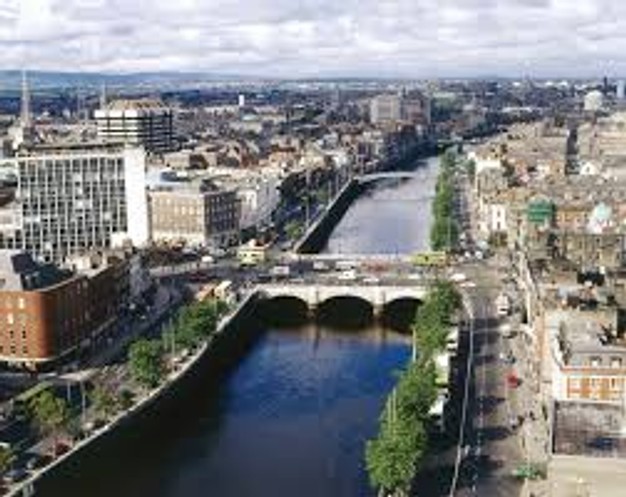
Dublin’s iconic river begins its course in the Liffey Head Bog region of the Wicklow Mountains. Making its descent through Newbridge, County Kildare, it meanders its way east before flowing straight through the heart of Ireland’s capital city to meet the sea at Dublin Bay.
Its current name originates from Magh Life (Liffey Plain), a fertile plain in Kildare through which it flows. However, in earlier times it was known as An Ruirthech, meaning ‘The Fast/Strong Runner’ or ‘The Stampeding One’; a name derived from its tendency for unpredictable currents and fast flooding.
It is also affectionately and poetically referred to as ‘Anna Liffey’ (or ‘Anna Livia’), supposed to be from a reformed pronunciation of ‘Abhainn na Life’.
The Three Sisters
An Triúr Deirfiúr
The Three Sisters
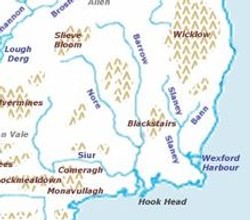
Three separate rivers converge as they enter the Celtic Sea off the south-eastern coast of County Waterford. They are known collectively as The Three Sisters.
The largest is of these is Ireland’s second largest river, the Barrow or An Bhearú, which has a total length of 192 kilometres (119 miles) rising in the Slieve Bloom Mountains (Sliabh Bladhma, meaning Bladh’s Mountain, after a chief of the Milesian race) of County Laois and flowing through counties Kildare, Kilkenny, Carlow, and Wexford before joining up with its sisters. It first appears in the Annals of the Four Masters rendered in the earlier form ‘Berbha’ in an entry for 466 AD; like with other rivers, this is speculated to relate to a river-goddess of the same name.
The middle sister is called the Suir or An tSiúr, but the origin and meaning of its name are unclear. At 185 kilometres (115 miles) in length, she is Ireland’s third largest river. Whilst she is slightly smaller in size than the Barrow, her flow is twice as powerful. Commencing in the Devil’s Bit Mountain of County Tipperary, it flows north towards Clonmel (Cluain Meala, meaning Honey Meadow) before veering east through Carrick-on-Suir (Carraig an tSiúr, meaning ‘Rock on the Suir’) then on through Waterford city before joining her sisters at Waterford Harbour, together they continue their course towards the Celtic Sea. At low tide a stone can be spotted in the Suir marking the boundaries of Tipperary, Waterford, and Kilkenny.
Like its sister, the Suir, the River Nore or An Fheoir (thought to mean a ‘boundary’) also starts its course in a region of the Devil’s Bit Mountain, County Tipperary. It has a total length of 140 kilometres (87 miles) flowing south-east towards Laois and Kilkenny before joining up with the River Barrow north of New Ross (Ros Mhic Thriúin, or ‘Forest of the Son of Treon’) in south-west Wexford.
River Corrib
Abhainn na Gaillimhe
River of Galway / Stony River
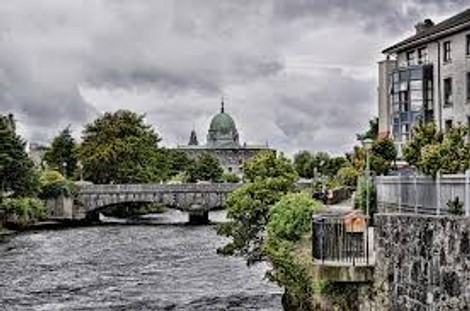
While being one of the shortest rivers in Ireland the force of the Corrib’s flow is mighty and second only to the River Shannon. One legend for the river’s name refers to Gaillimh, a daughter of Breasail, a chieftain of the Fir Bolg race, who drowned here. Nevertheless, the word ‘gaillimhe’ is also taken to signify ‘stoniness’, giving us the meaning ‘stony river’. It is from this river that the wider county of Galway (Gaillimhe) draws its name. Today it is more commonly called ‘the Corrib’ after its source at Lough Corrib (Loch Corrib – Ireland’s second largest lake), which the river connects to the Atlantic Ocean through Galway Bay after a short 6 kilometre (3.7 mile) journey.
The Blackwater (Munster)
An Abhainn Mhór
The Big/Great River
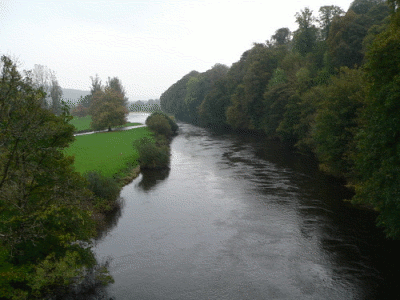
Rising on the Kerry side of the Cork and Kerry mountains, the Blackwater flows for 168 kilometres (104 miles) through Cork towards Waterford before entering the Celtic Sea via Youghal Harbour. Its modern name comes from English and has been rendered in Irish as An Uisce Dubh, but this is a reverse translation and not based on the original Gaelic for the river. Its original Gaelic name is An Abhainn Mhór, meaning the ‘Big or Great River’, properly transliterated as ‘Avonmore’ in English.
River Bann
An Bhanna
The Bann
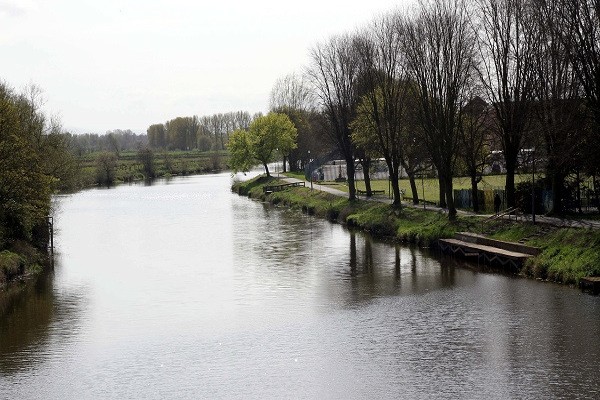
Rising in County Down on a peak of the Mourne Mountains called Slieve Muck or Sliabh Muc (Pig Mountain), the Bann first flows into Lough Neagh (Loch nEachach, meaning ‘Lake of Eachaidh’) before continuing north through Lough Beg (Loch Beag, or ‘Little Lake’) to meet the North Atlantic Ocean by way of Coleraine, County Derry. Its flow through Lough Neagh (the largest freshwater lake in both Ireland and Britain) naturally divides the river into the Upper Bann and Lower Bann, but with a joint length of 129 kilometres (80 miles) stretching across the entire province, they combine to form Ulster’s longest river. Earlier accounts record its name as ‘Banda’ and ‘Bandae’, which has led to the conclusion that the river’s name means simply ‘the Goddess’; determined from the individual root words ‘ban’ (a woman) and ‘dea’ (deity).
River Suck
An tSuca
The Suck
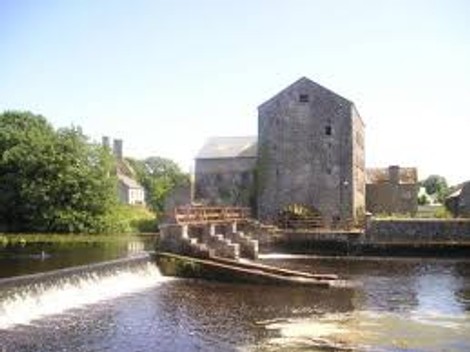
Flowing from Lough O’Flynn in east Roscommon, it joins the River Shannon at Shannonbridge (Droichead na Sionainne) in east Offaly. With a length of 133 kilometres (82.5 miles) the River Suck is Shannon’s main tributary.
The antiquity of this river’s name becomes clear through the uncertainty surrounding its origin and meaning. Although there are numerous mentions of ‘An tSuca’ within Early Irish Literature, the conviction of the meaning of this word has been lost as the Irish language progressed through the Old, Middle and Early Modern stages of its development. The best meaning we can discern is that ‘suca’ is a variation on the Old Irish word ‘succín’ (or in modern Irish ‘suicín’), meaning ‘amber’. If this assumption is correct, this name might simply be referring to the colour of the river.
River Erne
Abhainn na hÉirne
River of the Érnai
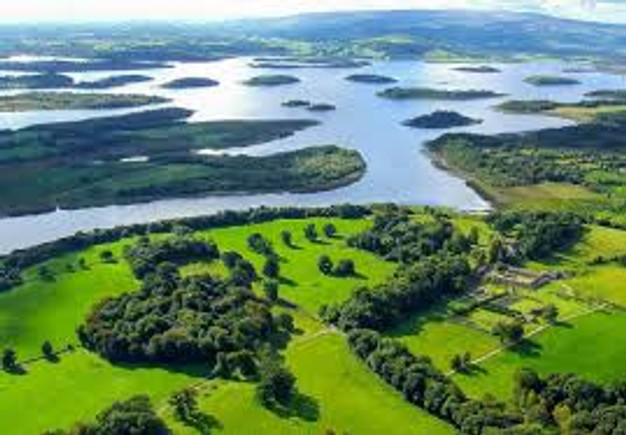
The River Erne rises in Lough Gowna (Loch Gamhna, meaning ‘Calf-Lake’) on the border of Longford and Cavan and heads northwards through Upper and Lower Lough Erne before veering west through Donegal and on to the Atlantic Ocean through Donegal Bay. Its total course is 129 kilometres (80 miles) long.
One source for the origin of its name suggests that it comes from an early group of people called the Érainn or possibly the Érnai, who in turn take their name from an ancient goddess; if this holds true Abhainn na hÉirne translates to mean the ‘river of (the goddess) Erne’.
